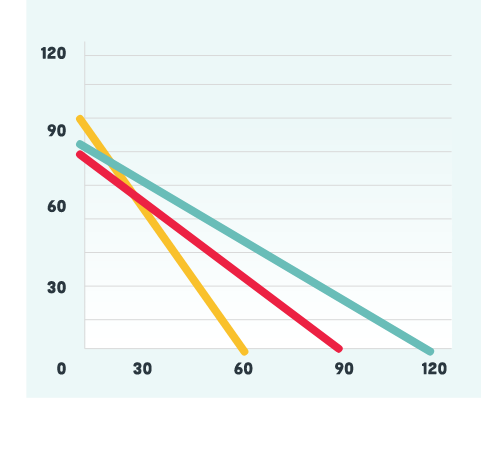Is our program delivering the right results? This is the key question marketers must ask themselves each and every day.
And yet, many times, we find ourselves slipping into execution mode, just working hard to complete activities, send that next Enews, or publish that next blog post. Executing isn’t good enough, our programs must perform. Absent performance awareness fumbles, sales teams don’t receive enough quality leads, and growth will slow.
So, how do you start shifting your approach? I recommend the following five-step process.

1. Dust Off Your KPIs (or Write Them)

The first step towards improved results for your programs is to reorient around your goals. If you have written key performance indicators (KPIs), pull them out and evaluate how well you are performing against them. Since this is going to be a regular activity, it’s smart to develop a dashboard inside your marketing software that you can reference (or a simple spreadsheet that someone on your team can update) so that it’s easy to quickly take a look and know where things stand. Note the following things:
- Where are we outperforming our KPIs? What might that mean?
- Where are we underperforming? What could be the cause of that underperformance?
- What underlying data will we need access to in order to determine why something is succeeding or failing?
The goal of this step is to understand where you are and what you need to look at next to drive better results.
Side Note: If you don’t have any marketing KPIs written down, now is a good time to start. We recommend you have a conversation with your marketing leadership to identify what success looks like for them and then compare that against your existing marketing performance to determine if it is achievable.
2. Set SMART Goals for the Next 30 Days
Once you have a good idea about how your program is performing, it’s time to choose where you want to go. While your KPIs may focus on what you want to achieve over the course of a year or a quarter, these goals should focus in on a shorter time frame like 30 days. Keep in mind that you don’t need to achieve everything in the next 30 days, but all of your 30-day goals need to add up to the overall annual goal.
The big thing for these goals is that they must be SMART.

SMART goals that are clearly defined will give you a clear idea of what done looks like and make choosing your next steps easier.
Need help creating your SMART goals? Download our free template here to get started!
3. Identify Where Your Program Is Succeeding and Boost It
When we are trying to improve performance, many of us immediately narrow our vision to the parts of our marketing program that are underperforming. I prefer a success-first approach. Before I look at what is broken, I am going to identify what is working and try to boost that effort until I get to the point of diminishing returns.
Let’s look at advertising, for example. If I’m running a lead gen campaign on Google and LinkedIn that is returning a 10:1 ROI, my recommendation will be to spend more money until results dip below a generally acceptable marketing ROI like 3:1. Why? Because running a campaign at a 10:1 ROI leaves money on the table that could otherwise be brought in simply by increasing the spend.
The same principle applies if you are judging program efficiency on cost per lead or cost per MQL. If your ad campaign is bringing in leads significantly below the cost per MQL goal, you should spend more until you reach the goal so that you do not leave any leads on the table.
4. Optimize Where Your Program Is Lagging Using an Optimization Framework
Once you’ve boosted any efforts that are working well, it’s time to optimize any efforts that are lagging. The best way to do this is with an optimization framework. A framework helps you systematically identify what is causing low performance so you know where optimizations are needed.
A Brave New’s optimization framework for inbound lead generation and customer acquisition evaluates the effectiveness of a program in three key areas:
- Traffic generation
- Conversion rate
- Lead quality
When we’re evaluating the effectiveness of a client program, we’ll review to identify whether the client has a traffic generation problem, conversion rate problem, or a lead quality issue. Once we’ve identified the cause, we can then pull from a standard set of optimizations within this category.
Side Note: This optimization framework works not only for an entire marketing program but also for something as simple as landing page performance. The framework allows you to quickly evaluate the landing page’s performance by determining whether it’s lagging behind in traffic, if the conversion rate isn’t performing up to benchmark, or if the leads that are filling out the form are high quality and relevant.
Let’s take a look at each element of our optimization framework and discuss some of the simplest optimization efforts that you can undertake in each category:
Make sure you use this optimization framework more than once. Each time you complete an optimization effort, record the results, and then run through the framework again to identify the next best effort.
5. Choose the Most Impactful Next Tactic
So far, we’ve focused almost exclusively on how to improve current efforts, but we know there are also always new tactics to implement. The key with new tactics is to not fall into the trap of trying to implement everything at once. Spreading out your efforts, especially if you have a small team, is a recipe for disaster. Our recommendation is to identify a new tactic, implement it, and only then move onto the next tactic.
Never Stop Optimizing
One of the best things about marketing today is that nothing remains static. It’s also one of the most challenging things. Once you’ve started your optimization efforts, it’s important that you keep going. Sure, you’re always going to have to launch that new blog or send out your monthly Enews, but these are just the basics. Following the five steps outlined in this post will help you not just execute the basics, but it will deliver the results that you need and that your organization demands in order to drive breakthrough growth.
A great place to get started is by creating your SMART goals. You can download our free template here!
Don’t miss out, get Brave News now
Join the ABN community and be the first to learn about trends in inbound marketing, branding, and web design.








